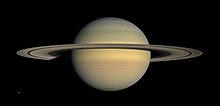Solar System/Saturn
Saturn is the sixth planet from the Sun and is the second largest planet (after Jupiter), with a diameter of 120536 kilometers (9.4 times that of Earth). Saturn is known for its spectacular rings, which can be clearly seen with a home telescope of modest size. Saturn is one of the four gas giants. Even though Saturn is much more massive than Earth, if it had a solid surface and you stood on it you would weigh only 6% more than you do on Earth. This is because you would be standing much farther from the center of the planet than you do on Earth.

Orbit edit
Saturn orbits the Sun in 29.46 Earth-years, with an orbital eccentricity of 0.05 and an average distance from the Sun of 9.54 AU (Earth-Sun distances).
Rotation edit
Saturn rotates prograde (in the direction of its path around the Sun) once every 10 hours 14 minutes, with an axial tilt of 25.33°.
Physical characteristics edit
Saturn is the only planet that is less dense than water—in fact its density is just 0.69 that of water.
Regions edit
Atmosphere edit
Clouds and winds edit
Spots edit
Vortices edit
Internal structure edit
Magnetic field edit
Magnetosphere edit
Rings edit
The most beautiful planetary system edit
The discovery Of Saturn's rings edit
Composition of the rings edit
The origin of the rings edit
The shepherd satellites edit
"Spokes" or radial formations edit
Satellites edit
Titan edit
Titan is the second largest moon in the solar system and has a diameter over 5% greater than that of the planet Mercury. It is the only planetary moon that has a thick atmosphere made of nitrogen. Titan has lakes made of liquid methane.
By 7.8 billion years in the future, when Sun will become a red giant star, Titan will become habitable.
-
Titan in true color.
-
Haze from the atmosphere of Titan.
-
Image from the surface of Titan, taken by the probe Huygens.
-
Diagram of Titan.
Mimas edit
-
Mimas
-
Crater on Mimas
Enceladus edit
-
Enceladus
-
Close up
-
Terrain close up
-
Plumes of Enceladus
-
Orbit of Enceladus
Tethys edit
-
Tethys